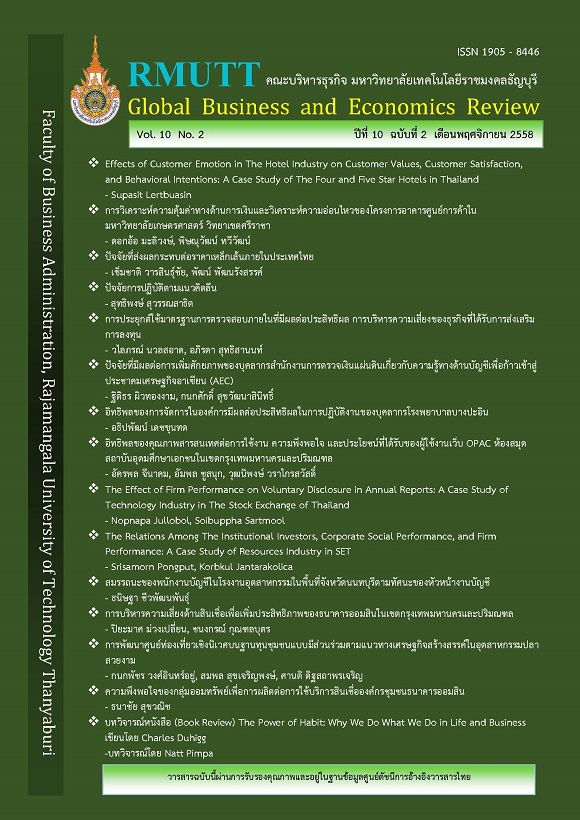อารมณ์ของลูกค้าในอุตสาหกรรมโรงแรมที่มีผลต่อคุณค่าของลูกค้า ความพึงพอใจของลูกค้า และความตั้งใจทางด้านพฤติกรรม กรณีศึกษา โรงแรมระดับ 4 ดาวและ 5 ดาว ในประเทศไทย
คำสำคัญ:
อารมณ์ของลูกค้า, อุตสาหกรรมโรงแรม, คุณค่าของลูกค้า, ความพึงพอใจของลูกค้า, ความตั้งใจทางด้านพฤติกรรมบทคัดย่อ
วัตถุประสงค์สำคัญของการศึกษาในครั้งนี้คือ การนำเสนอรูปแบบการบูรณาการเพื่อตรวจสอบความสัมพันธ์ท่ามกลางองค์ประกอบทางอารมณ์ของลูกค้า ได้แก่ ความปรารถนาและความตื่นตัว องค์ประกอบด้านคุณค่าของลูกค้า ได้แก่ คุณค่าด้านความสุขสบายและคุณค่าด้านประโยชน์ใช้สอย ความพึงพอใจของลูกค้าและความตั้งใจทางพฤติกรรมของลูกค้าในอุตสาหกรรมโรงแรม การศึกษานี้เป็นงานวิจัย แบบผสมวิธีเชิงอธิบายเป็นลำดับ ประกอบด้วยการเก็บข้อมูลโดยใช้แบบสอบถามและวิเคราะห์ข้อมูลเชิง ปริมาณและการสัมภาษณ์ผู้บริหารโรงแรมเป็นลำดับต่อไป จำนวนแบบสอบถามที่รวบรวมได้ทั้งหมด 779 ชุด จากลูกค้าที่ใช้บริการโรงแรมจากการสุ่มตัวอย่างโรงแรมระดับ 4 และ 5 ดาว จากสี่ภูมิภาคของประเทศไทย และทำการวิเคราะห์ทางสถิติหาความสัมพันธ์ของโมเดลเชิงโครงสร้างโดยใช้โปรแกรมลิสเรล 8.80 ผลจากการศึกษาพบว่า ปัจจัยด้านความปรารถนาส่งผลทางตรงและทางอ้อมต่อความตั้งใจทางด้านพฤติกรรมของลูกค้า ขณะที่ความตื่นตัวส่งผลต่อความตั้งใจด้านพฤติกรรมของลูกค้าโดยผ่านองค์ประกอบด้านผลประโยชน์ใช้สอยหรือผ่านองค์ประกอบด้านความพึงพอใจของลูกค้าหรือทั้งสององค์ประกอบ ข้อเสนอแนะ งานวิจัยครั้งต่อไปควรจะศึกษาในกลุ่มตลาดลูกค้าโรงแรมระดับ 1 ถึง 3 ดาว เพื่อยืนยันผลการศึกษาที่ค้นพบ จากครั้งนี้ นอกจากนี้แล้ว งานวิจัยสำหรับอุตสาหกรรมโรงแรมครั้งต่อไป ควรศึกษาปัจจัยทางการตลาดด้าน อื่น อาทิ คุณค่าตราสินค้า ภาพลักษณ์ตราสินค้า ยิ่งไปกว่านั้น ขอบเขตการศึกษาควรจะขยายไปยังกลุ่มงาน ด้านการบริการอื่น อาทิ ภัตตาคาร สถานบันเทิง การกีฬา เป็นต้น
References
Bigne, J. E., Andreu, L., & Gnoth, J. (2005, December). The theme park experience: An analysis of pleasure, arousal and satisfaction. Tourism Management, 26(6), 833- 844.
Choi, T., & Chu, R. (2001). Determinants of hotel guests’ satisfaction and repeat patronage in The Hong Kong hotel industry. International Journal Hospitality Management, 20, 277-297.
Creswell, J. W., & Plano Clark, V. L. (2011). Designing and conducting Mixed Methods Research (2nd ed.). Los Angeles: SAGE Publications. Cronin et al. (2000). Assessing the effects of quality, value, and customer satisfaction on consumer behavioral intentions in service environments. Journal of Retailing, 76(2), 193-218.
Field, A. (2005). Discovering statistics using SPSS (2nd ed.). Thousand Oaks, CA: Sage Publication.
Hair, J. F., Black, W. C., Babin, B. J., & Anderson, R. E. (2010). Multivariate data analysis (7th ed.). Upper Saddle River, New Jersey: Prentice - Hall.
Irani, N., & Hanzaee, K. H. (2011). The effects of variety-seeking buying tendency and price sensitivity on utilitarian and hedonic value in apparel shopping satisfaction. International Journal of Marketing Studies, 3(3), 89-103.
Keillor, B., Hult, G. T., & Kandemir, D. (2004). A study of the service encounter in eight countries. Journal of International Marketing, 12(1), 9-35.
Kim, B., & Oh, J. (2011). The difference of determinants of acceptance and continuance of mobile data service: A value perspective. Expert Systems with Applications, 38, 1,798-1,804.
Ladhari, R. (2007).The effect of consumption emotions on satisfaction and word of mouth communications. Psychological Marketing, 24(12), 1,085- 1,108.
LeBlanc, G., & Nguyen, N. (1996). An examination of the factors that signal hotel image to travelers. Journal of Vacation Marketing, 3(1), 32-42.
Lindeman, R. H., Merenda, P. F., & Gold, R. Z. (1980). Introduction to bivariate and multivariate analysis. Glenview, III: Scott, Foresman.
Manhas, P. S., & Ramjit, J. (2013). Customer experience and its relative influence on satisfaction and behavioral intention in hospitality and tourism industry. South Asian Journal of Tourism and Heritage, 6(1), 53-68.
Mehrabian, A., & Russell, J. A. (1974). An approach to environmental psychology. Cambridge, MA.: Massachusetts Institute of Technology.
Qin, H., & Prybutok, V. R. (2008). Determinants of customer-perceived service quality in fast- food restaurants and their relationship to customer satisfaction and behavioral intentions. The Quality Management Journal, 15(2), 35-50.
Rovinelli, R. J., & Hambleton, R. K. (1977). On the use of content specialists in the assessment of criterion referenced test item validity. Dutch Journal of Educational Research, 2, 49-60.
Russell, J. A. & Pratt, G. A. (1980). A description of the affective quality attributed to environments. Journal of Personality and Social Psychology, 38(August), 311-322.
Ryu, K., & Han, H. (2011). New or repeat customers: how does physical environment Influence their restaurant experience?. International Journal of Hospitality Management, 30, 599-611.
Ryu, K., Han, H., & Jang, S. S. (2010). Relationships among hedonic and utilitarian values, satisfaction and Behavioral intentions in the fast-casual restaurant industry. International Journal of Contemporary Hospitality Management, 22(3), 416- 432.
Schiffman, L. G., & Kanuk , L. L. (2000). Consumer Behavior (7th ed). Upper Saddle River, NJ.: Prentice-Hall.
Walsh, G., Shiu, E., Hassan, L. M., Michaelidou, N., & Beatty, S. E. (2011). Emotions, store- environmental cues, store-choice criteria, and marketing outcomes. Journal of Business Research, 64(7), 737-744.
Wakefield, K. L., & Blodgett, J. G.(1996). The effect of the servicescape on customers’ behavioral intentions In leisure service settings. The Journal of Service Marketing, 10(6), 45-61.
Yamane, T. (1967). Statistics: An introductory analysis (2nd ed). New York: Harper and Row. Yuksel, A. (2007). Tourist shopping habitat: Effects on emotions, shopping value and behaviours. Tourism Management, 28, 58-69.
Yuksel, A., & Yuksel, F. (2007). Shopping risk perceptions: Effects on tourists’ emotions, satisfaction and expressed loyalty intentions. Tourism Management, 28, 703-713.
Zeithaml, et al. (1996). The behavioral consequences of service quality. Journal of Marketing, 60(2), 31-46.
Downloads
เผยแพร่แล้ว
How to Cite
ฉบับ
บท
License
บทความที่ได้รับการตีพิมพ์เป็นลิขสิทธิ์ของผู้นิพนธ์
ข้อความที่ปรากฏในบทความแต่ละเรื่องในวารสารวิชาการเล่มนี้เป็นความคิดเห็นส่วนตัวของผู้เขียนแต่ละท่านไม่เกี่ยวข้องกับมหาวิทยาลัยเทคโนโลยีราชมงคลธัญบุรี และคณาจารย์ท่านอื่นๆในมหาวิทยาลัยฯ แต่อย่างใด ความรับผิดชอบองค์ประกอบทั้งหมดของบทความแต่ละเรื่องเป็นของผู้เขียนแต่ละท่าน หากมีความผิดพลาดใดๆ ผู้เขียนแต่ละท่านจะรับผิดชอบบทความของตนเองแต่ผู้เดียว







